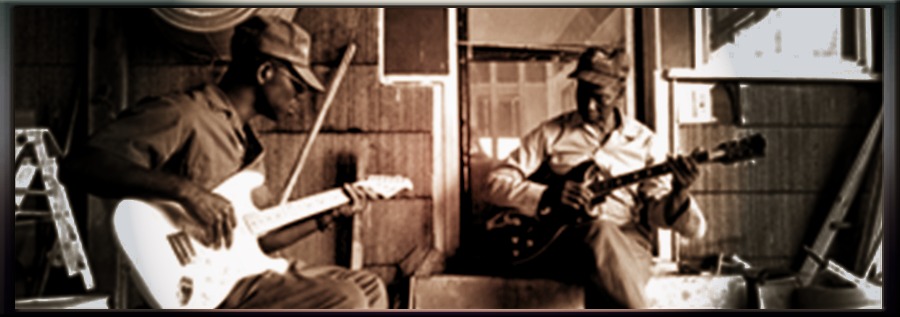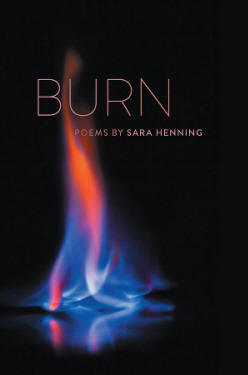
~ Delta Poetry Review ~
Sara Henning's Book Review by Stephen Furlong
|
Henning, Sara. Burn: Poems.
Southern Illinois University Press, 2024.
74 pp. $18.95
In the essay “In
Search of a Language” from her 1995 book Object Lessons: The
Life of the Woman and the Poet in Our Time, Eavan Boland
posits that “[T]here is a defining moment which comes early
in a poet’s life. A moment full of danger. It happens at the
very edge of becoming a poet, when behind there is nothing
but the mute terrain where, until then, a life has been
lived and felt without finding its formalization.” In
spending time with Burn by Sara Henning, readers will
recognize the defining moments in the speaker’s life as
those surrounded by flame, giving way to the duality of
flame itself: destruction and rebirth, love and loss. But
what endures, what comes after, is a book of strength,
influence, and determination—Sara Henning’s Burn is a
field map that guides readers through the flames to find the
clearing, and time and time again, the clearing is defined
by love.
In the opening poem, “Galveston, Texas,” Henning begins with
an arresting image:
When Brown Pelicans torpedo
the Texas coast, flare their gular pouches
to sieve for prawns, they look
like bombs falling from the sky.
Tell me the world is on the verge
of ending, and I’ll believe you.
The raw nature of the birds renders the
speaker “sea-shocked” and, further still, “[E]ven the wind//
seems complicit, brutalizing dunes,” allows the reader to
recognize the full magnitude of power in this poem. An early
thread in Henning’s book is the impact of naming—this is
revealed through the “warlike names” of the pelicans: “pod,
squadron, fleet—”; as such, this thread stitches an
enduring focus and command to Henning’s poems.
Speaking of naming, there are many influences weaving
through Burn – book and section epigraphs ranging from Delmore Schwartz to Tennessee Williams to Toni Morrison
provide glimmers of insight into the poet and the poems. As
an epigraph lover myself, they are streaks of light through
the window blinds, but reach the window and open the blinds
and behold: a profound, meaningful experience awaits.
Speaking of light—one poem I keep returning to is “A Brief
History of Light.” Written across eleven tercets, Henning
opens with another striking image:
They will always be love letters,
closed caption letters unspooling across
the TV My mother, hard of hearing,
watched her stories in silence.
Guiding Light, One Life to Live,
living room lit by two Tiffany lamps.
Simply put, there’s great tenderness to Henning’s words
here, and the love in this poem is palpable. The Tiffany
lamps also certainly shine in the speaker’s memory, as
Henning writes further:
How many times did I stare into
a lampshade, its luster blunted through
coiled bronze and blown favrile
the canopy of glass in rich charade
all night?
Favrile glass, which was patented by Louis Comfort Tiffany
in the late 1890s, is revered for its hand-crafted nature
which, in turn, adds depth to this poem even further still
because of the precision and the focus wielded by Henning
herself. Speaking of hand-crafted nature, Henning works
magic as the poem’s landscape becomes the speaker’s youth:
…I’m tilling mica from soil at recess,
swearing it would catch fire in my hands.
I imagined angels tunneling through
layers of earth, catching their wings
on oak roots, bricks, and those little wounds
lodging there, waiting for me
to dig them up with sticks.
For as much as the poem is about light,
the poem can also serve as a field map for faith. The author
notes in the back of the book indicate this poem nods to
Billy Collins’s titular poem from Questions about Angels
(University of Pittsburgh Press, 1991); arguably, that poem
itself is a tongue-in-cheek meditation on how angels pass
their time, as well as the healing power of dance.
Conversely in Henning’s poem, by imagining angels coming
from the ground as opposed to the sky, the readers of this
poem can feel the speaker’s swelling pride in uncovering
“Goody’s barrettes” which makes the poem’s close—one that
brings those lamps that lit up the living room earlier in
the poem—into the speaker’s possession even more
rewarding. To me, this poem alludes to Eavan Boland’s
defining moment I spoke to earlier and, further still,
Boland writes “all the rough surfaces give way to the polish
and slip of language.” In Burn, the rough surfaces
of Henning’s poems are often rife with flames, embers, and
ashes.
However, to continue the metaphor, the
memories locked in this poem are like that of kindling, but
here’s where Henning’s strength to wield and operate
language allows for a sense of healing, of understanding,
that may not have been there in the initial formation of the
memory. That is because, through the unearthing of seemingly
miniscule trinkets like barrettes, a closer reading reveals
the healing happens through the uncovering and the
unearthing. That, just as well, could be the poet’s work: to
uncover and unearth. And, as such, this notion speaks
volumes to exploration Henning does in not just this poem
but the poems in Burn as a whole.
That’s where the healing happens.
Speaking of healing, the last poem I
want to touch on before I close this review is “Drive-In
Nights”; the poem is a kind of sestina-like variation,
especially with its word repetition and tercet envoy that
closes the poem. The poem opens with a Dorianne Laux line
which, just as well, could speak to the book’s intent:
you know love when you see it,
you can feel its lunar strength, its brutal pull.
As a lover of words, Laux’s use of
brutal strikes me just as a recurring word in Henning’s
poem strikes me, too: mercy. Given the context of the poem,
watching Die Hard with a loved one, the speaker in
this poem opened my heart with this question: “Who would
save us now?” And further still my heart opened with the
braiding of the poem’s narrative structure:
I can’t resist a man who’d kill
for his woman, a Johnny-come-lately who mercies
no one. I married you, husband, when you side
-swiped my heart. Terrorists fire,
take hostages. Hans Gruber calls shots. Once, we
caught fire
when we touched. In the fury of summer, got hitched.
We’ve fought, loved, made up in continuous cycles.
The fusion of movie plot with life story
is revelatory, and what’s striking to me is the poem’s
directness. As a teacher I once had would say, the poem
wastes no steps. This poem encompasses the love and passion,
the intensity and desire, which speaks to the collection as
a whole. Henning is also keenly aware of the poetic line
here, offering exciting dual meanings and thoughtful lines.
This poem makes me think of a Galway Kinnell line I had
taped to my writer’s desk for some time: “the secret title
of every good poem might be ‘Tenderness.’”
I would wager Kinnell’s adage rings true
for many of Henning’s poems housed in Burn.
Burn
is a book that interrogates how love takes shape in our
lives – and the book’s range is a testament to the effort
Sara Henning put into curating this text. I admire, with
great regularity, her exploration of form because these
moments are where Henning herself wields flame and creates
enduring poems like “Stealing Ariel” and “A Brief
History of Fire” that also anchor the book.
Simply put, Sara Henning’s Burn
is a rewarding and nourishing book. |
| Archive | Submissions | About | News |
